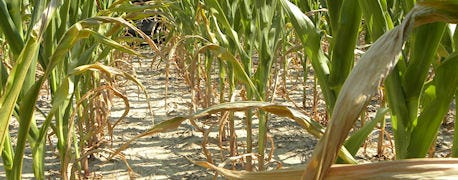

Test For Nitrates If Chopping Drought Stressed Corn
In drought-stricken areas this year, corn yields may likely end up being measured by tons of forage, not bushels of grain. If you are going to chop or bale droughty corn plants for forage, or chop the crop for silage, what are the risks of causing nitrate poisoning when feeding the forage to cattle? The risk of having concentrations of nitrates in the forage that are high enough to cause problems are diminished when the corn crop is chopped for silage. The ensiling process and fermentation that takes place in the silo reduces nitrate levels, making the forage much safer for livestock consumption. However, "that's not the case if the corn crop is green chopped or grazed," says Steve Barnhart, Iowa State University Extension forage agronomist. For silage, if the crop is dying prematurely, the chopping decision should be made while there is still enough moisture in the stalks to properly ensile the crop. If no grain forms and the stalks remain alive, the silage chopping timing can be delayed.
If chopping drought-stressed corn, he suggests you follow these steps:
* Test for nitrates. Read the ISU fact sheet on nitrate toxicity and testing.
* Test crop moisture. Test the moisture of the chopped plant for proper ensiling to insure good fermentation. Good fermentation is important to reduce nitrate levels in the feed. Don't be fooled by how dry the drought damaged corn looks. It may still have too much moisture -- too wet to ensile.
To determine actual whole plant moisture you need to sample some representative plants from the field. Chop the plants, maybe run them through a chipper-shredder or other device. Test for moisture using the Koster moisture tester, or other method such as a microwave oven or heat lamp.
~~~PAGE_BREAK_HERE~~~
If the moisture is over 70%, the problem then becomes how to harvest and properly ensile this forage. The answer is easy, but to accomplish this is difficult. The answer is to add dry matter to reduce moisture content. Air dry alfalfa or grass forage will decrease the moisture content of wet forage approximately 5 percentage points for each 150 to 200 pounds of material added per ton of wet forage weight.
Well-fertilized crops, under stressed conditions caused by drought, have higher nitrate levels than non-fertilized crops. Also, plant parts closest to the ground contain the highest concentrations of nitrates. Most are in the lower third of the plant.
Be careful grazing stalks, cattle can run into nitrate poisoning there, too
With this in mind, strip grazing is not recommended, says ISU Extension livestock specialist Byron Leu. This practice forces animals to eat all of the plant. Overgrazing isn't recommended for the same reason, as cattle will be forced to consume plant parts with greater levels of nitrates. If grazing is your preferred choice for using high nitrate crops, livestock shouldn't be allowed access if they are especially hungry.
Hay or other forages should be provided to them prior to turn-out. Only allow the livestock access for a portion of the day to begin with. This is recommended until the livestock become acclimated to the higher nitrate levels.
If the crop is harvested for silage, cutting heights should be adjusted higher, leaving the lower stalk unharvested, says Leu. Although the costs involved with mechanically harvesting high nitrate crops for forage are significant, there are livestock safety benefits to this approach.
The ensiling process reduces nitrate levels making them much safer for consumption. However, it is not recommended to green chop these forages and let them heat overnight as this process favors the formation of nitrite which is even more toxic than nitrate. The bottom line is, notes Leu, if drought-stricken corn is harvested as forage, be careful about nitrates.
About the Author(s)
You May Also Like




